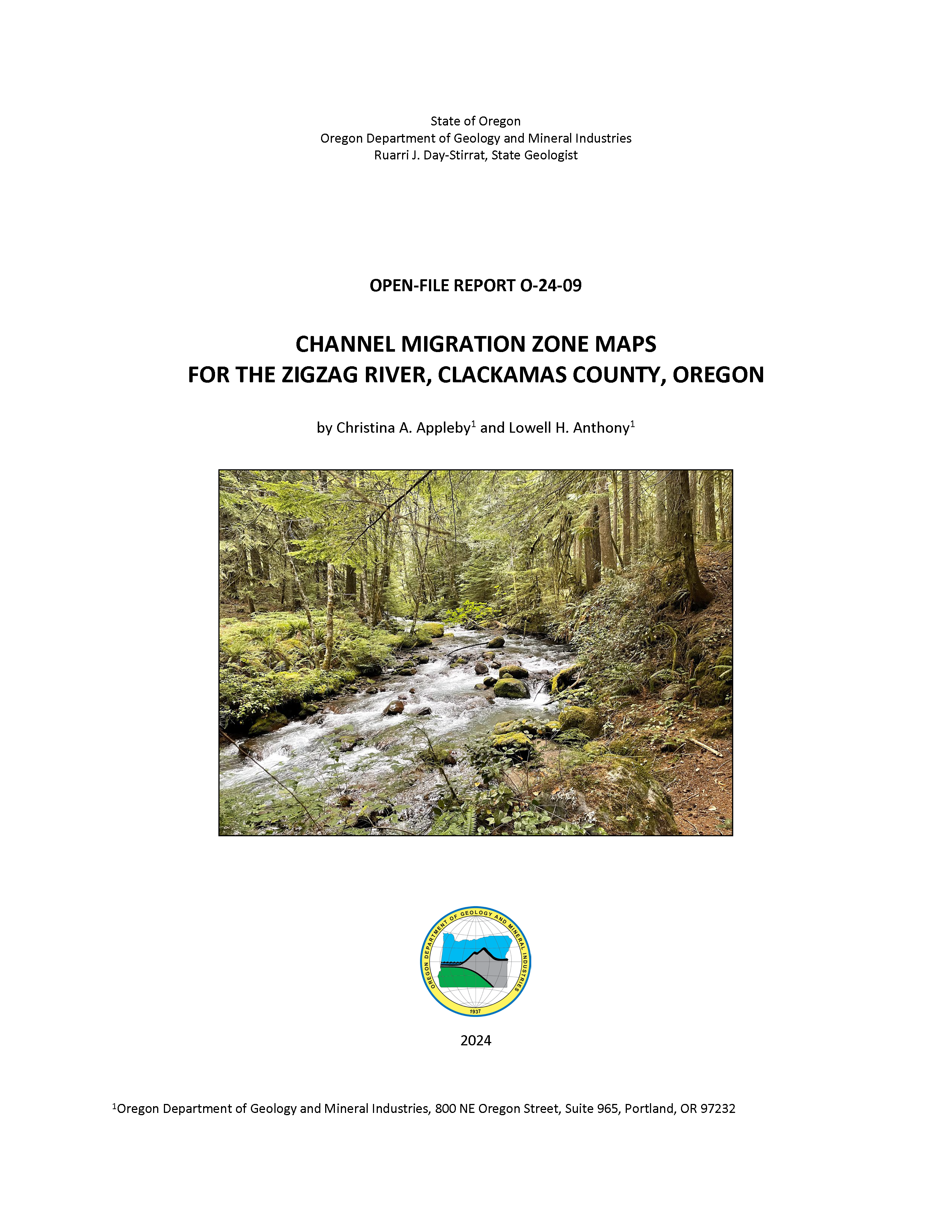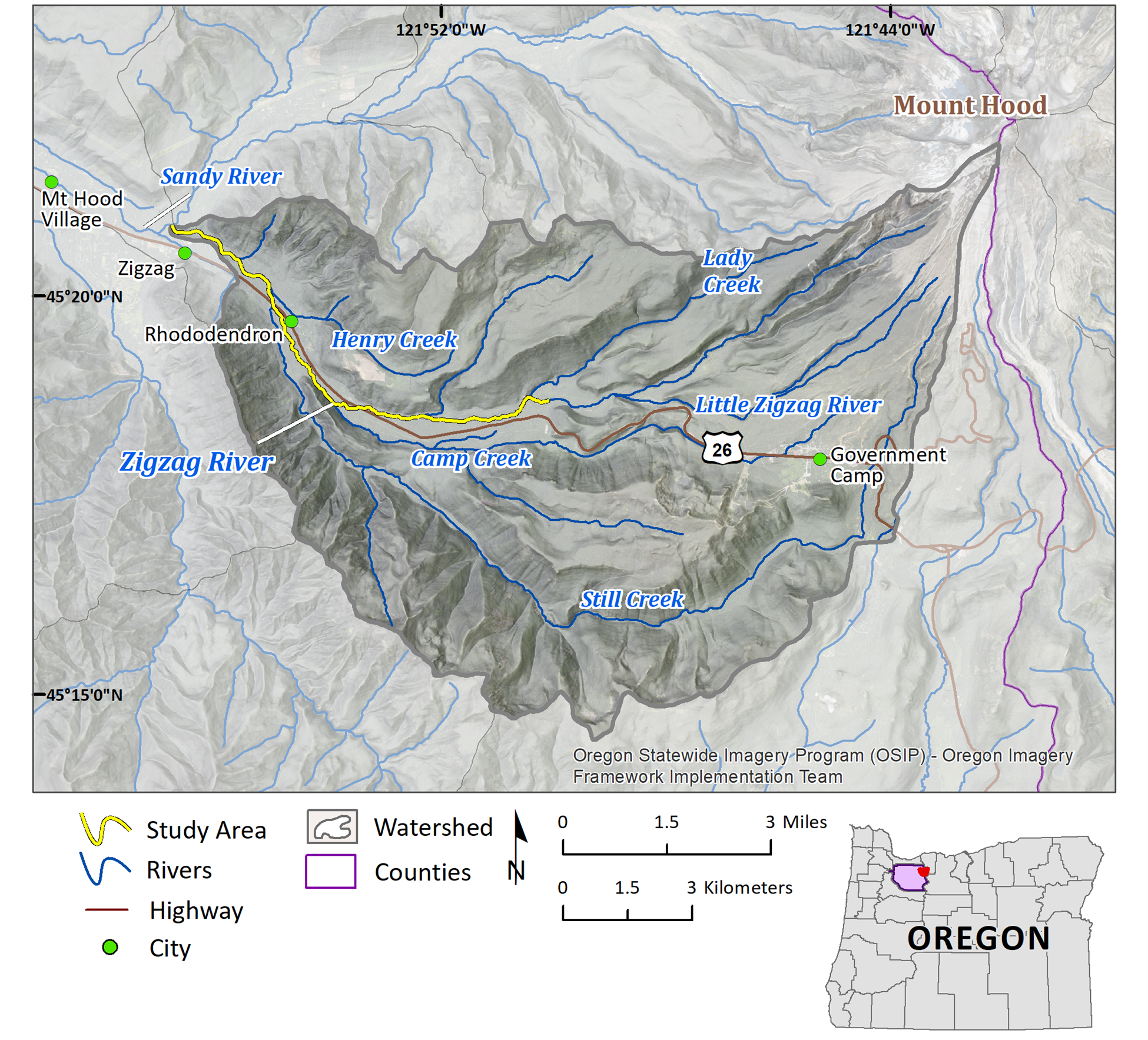DOGAMI OPEN-FILE REPORT SERIES
Publication Preview

Open-File Report O-24-09, Channel Migration Zone Maps for the Zigzag River, Clackamas County, Oregon, by Christina A. Appleby and Lowell H. Anthony; 43 p. report, one Esri® geodatabase with internal metadata, external metadata in .xml format, one spreadsheet in Excel format.
WHAT’S IN THIS REPORT?
This report describes the methods and results of channel migration zone mapping for the Zigzag River in Clackamas County, Oregon. This information can help communities plan and prepare for natural disasters.
PUBLICATION DOWNLOADS
EXECUTIVE SUMMARY
This study provides Oregon communities with new information about the natural hazards associated with channel migration. During 2023 and 2024, the Oregon Department of Geology and Mineral Industries (DOGAMI) produced channel migration zone (CMZ) maps for the Zigzag River in Clackamas County. These maps are the first of their kind published for this river.
CMZ maps define the area in which a given stream is likely to move laterally and change its channel course within the next 30 and 100 years. In this study, we mapped CMZs along the lower 7.8 mi (12.5 km) of the Zigzag River. The components of these CMZ maps are the active channel; historical migration area; 30-year high, 30-year medium, and 100-year low erosion hazard areas; avulsion hazard area; and flagged streambanks. The method we used was primarily based on the interpretation of historical aerial photographs, high-resolution lidar topography, geologic maps, and flood inundation maps.
Overall, our results show that the Zigzag River is a highly dynamic system; all of the segments in the study area experienced some degree of lateral migration during the last 66 years and remain vulnerable to future channel migration. During the catastrophic December 1964 flood, the Zigzag River underwent widespread, accelerated change during which the banks and floodplain were heavily eroded, and the channel avulsed to new locations in several areas. The maximum erosion rates within each river segment ranged from 8.9 to 40.4 ft/yr (2.7 to 12.3 m/yr). After the 1960s, lateral migration has continued, but at a more modest pace and smaller extent; between 1995 and 2022, the majority of the channel migration occurred in the lower 1.4 mi (2.3 km) of the river.
From a broader geologic perspective, the Zigzag River is located within the Mount Hood region; this area has been heavily impacted by multiple hazards and the interactions between these hazards can be complex. While the purpose of this study is to examine the channel migration hazard, the history of volcanism, landslides, and debris flows must also be recognized. The next time a volcanic eruption or very large debris flow fills the river channel or valley with sediment, the Zigzag River may take decades, if not centuries or longer, to reestablish a channel and floodplain. Even a series of smaller events, such as multiple years with large debris flows, can cause significant damage and major changes to the floodplain. Channel migration rates and patterns will be highly unpredictable during this period of disequilibrium, and the maps produced in this study would need to be updated.
CMZ maps are designed to aid in community planning, raise awareness of river flood and erosion hazards, and inform decisions about environmental and emergency management and land use. The maps may be used to identify which buildings, critical facilities, transportation infrastructure, and utility lines are potentially at risk from channel migration and to prioritize areas for pre-disaster risk reduction. The maps in this study do not replace a site analysis by a land surveyor, geologist, or engineer. These hazard maps will provide a timely and valuable resource for the county and community planning efforts, including during the development of emergency plans and natural hazard mitigation plan updates.
GEOGRAPHIC INFORMATION SYSTEM (GIS) DATA
Geodatabase is Esri® version 10.7 format. Metadata is embedded in the geodatabase and is also provided as separate .xml format files.
Each dataset listed below has an associated, standalone .xml file containing metadata in the Federal Geographic Data Committee Content Standard for Digital Geospatial Metadata format.
|
Dataset Type |
Description |
Channel Migration Zone (CMZ)
| This polygon represents the area within which a channel is likely to move laterally during the following 100 years.
|
Active Channel (AC)
| This polygon represents the area within the floodplain that regularly conveys water including the exposed, unvegetated sediment deposits both within and adjacent to the river.
|
Historical Migration Area (HMA)
| This polygon represents the channel has occupied in the historical photographic record, including the active channel.
|
High Erosion Hazard Area (EHA)
| This polygon represents the areas with high potential to be impacted by lateral migration and channel widening during the following 30 years based on median historical erosion rates.
|
Medium Erosion Hazard Area (EHA)
| This polygon represents the areas with medium potential to be impacted by lateral migration and channel widening during the following 30 years based on maximum historical erosion rates.
|
Low Erosion Hazard Area (EHA)
| This polygon represents the areas with low potential to be impacted by lateral migration and channel widening during the following 100 years based on maximum historical erosion rates.
|
Avulsion Hazard Area (AHA)
| This polygon represents the areas with the greatest potential to be impacted by rapid channel diversion and occupation.
|
Flag
| This polyline represents the channel banks which have been identified for further geotechnical inspection due to signs of recent migration, location directly adjacent to landslide deposits, or areas of greater uncertainty due to pyroclastic and lahar deposits.
|
Study Area
| This polygon represents the study area extent.
|
Study Area
Figure 1 1. Study area (highlighted in yellow) with nearby communities and major tributaries in northeastern Clackamas County, Oregon. The context map shows the location of full Clackamas County (purple) with the Zigzag River watershed highlighted in red.
